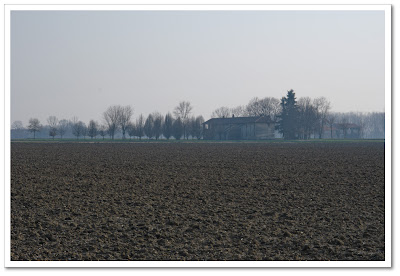
A blog about my landscape image making. On landscape imaging in general, bits of history and related disciplines (Architecture, Geography, Neuro Science, Philosophy and whatever happens to get my attention)
2010-03-22
Parco Agricolo Sud Milano. Rites of passage #5
Just some notes on the place. Imagine a huge garden of about 460 square Kilometres (287 square Miles). Cultivated since 2100 years ago. With a capillary irrigation network and an abundance of water, coming all year long from the Alps. The Roman Republic began it's massive exploitation of the area, levelling the soil, regulating the waters and cutting the original vegetation that covered every thing for centuries. Thousands of slaves from the past up to the present day. Once the brute force of the bodies today the brute mechanic means. Laser levelled slope. In the middle ages it was a place of power and abundance. Today a terrain waiting to be built. Home of the love for the horizontal in architecture, as opposed to the north European, Gothic, uprightness. The very best natural resort near Milan almost unnoticed by most of its inhabitants ... Parco Agricolo Sud Milano (PASM).
2010-03-18
Parco Agricolo Sud Milano. Rites of passage #4
Visual culture, cognition and photographers ...
The written part of almost all of my recent posts have had as a central point that is the space, his creation and the relations a viewer establishes within. More ambitiously I'm trying to position Landscape photography (and photography at large) as a conceptual space itself in a sort of recursion. A landscape is nothing other than a piece of space who's borders are settled in many ways. A landscape picture is itself a newly created landscape and so on. But, at this point, one may wonder if all of this may be something merely tangent to photography, given the commonality of vision and the related cognitive processes to all mankind. So what differentiates a photographer from the generic human viewer ? Well, in my view :-), there are at least two answers. The first, quite simply, is nothing. The second, which is the one I'm interested in, is that a photographer is a very specialized and trained kind of viewer. I would like to say a "Critical" viewer. But in our western culture the role of vision has always been questioned either by the Judeo–Christian Religion, that relied heavily on the "word" as a foundation for its beliefs, or by the most important source of modern knowledge: Science, that always saw with suspicion the mere "viewed" phenomena given the illusions that, in critical conditions, may be misguiding. Only in recent times has it been pointed out the ability to manipulate perspective may be at the base of the general paradigmatic shift which occurred in the seventeenth and sixteenth century that lent to the scientific revolution. If you want to dig deeper into the topic a good starting point may be this paper from Bruno Latour.2010-03-10
2010-03-08
Parco Agricolo Sud Milano. Rites of passage #2
I've have to confess that sometimes I envy neo cons for their ability to amuse and entertain people. But this time I think that the World Press Photo Jury went beyond the simple entertainment, the case reported here and here is nothing less than a nifty Comic Opera. No matter if the picture was heavily CartierBressoned the problem was the usual obliterated foot floating around that got lost after a heavy trimming that obliterated the unfortunate owner. Its interesting how the latter obliteration was considered perfectly acceptable. Can't believe it. I think that following those contests is becoming a must. Cant miss the next move to defend the magic objective automata in our hands ... But on the bright side the effect may be exactly the opposite of what desired, at least I hope so.
2010-03-04
Parco Agricolo Sud Milano. Rites of passage #1
Perhaps its some pre industrial piece of my cognitive system floating around but I'm quite sensible to seasonal changes. Can't get used to this. Photographically speaking the passage from Winter to Spring is always busy. Things happen at such a speed. Nature -- if we may still call it that way -- at the latitudes from which I'm writing is exploding of life again and it happens in a really compressed interval of time. I'm a bit late on my schedule on the theoretic neighbourhoods too. To be honest the main reason is that I've decided, before prosecuting, to have a look at Kant's "inaugural dissertation of 1770" mainly cause it seems a good liminal space in which perform a passage from Geography to Philosophy. But I've forgot how Kant is hard to read so it will take a bit more time and posts to get there. Apologies for this.
Subscribe to:
Comments (Atom)

























